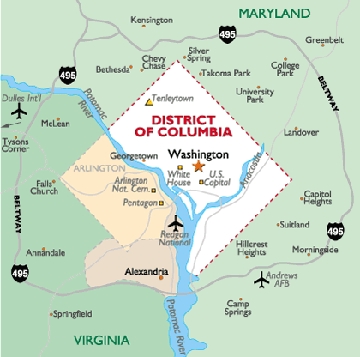United States EPA Proposes "Next Generation" of Rainwater/Stormwater Controls in Clean Water Permit for Washington, DC

Developers would be required to capture and retain first 1.2 inches of rainfall on-property
(PHILADELPHIA) April 21, 2010 – The U.S. Environmental Protection Agency has announced plans to require green roofs, rain barrels and other measures that capture runoff at new and redeveloped buildings in the District of Columbia. This makes Washington a test case for an ambitious effort to stop pollution from flowing into rivers along with the rain.
Goal is to Protect Chesapeake Bay
The proposed permit for the District’s storm-sewer system would require developers to trap 90 percent of the water that falls on a property during a rainstorm.
“The innovations in this new permit are vital to restoring and protecting the health of local waterways in the District, as well as the Chesapeake Bay,” said Shawn M. Garvin, EPA mid-Atlantic Regional Administrator. “We all need to do our part, and this permit can serve as a model to other municipalities for preventing runoff from washing harmful pollutants into streams and rivers in the Bay watershed.” Click here to access the EPA news release.
New Permit Requirements
The permit requires the District of Columbia to take progressive steps that were not required by the old permit issued in 2004, including:
- Implementing a sustainable and enforceable approach to promoting low impact development and green infrastructure, including enhanced tree planting, green roofs, and water reuse onsite to slow down the rate of runoff from paved areas of the District.
- Complying with strict discharge limits, and new performance standards requiring 90 percent on-site retention of storm flows at non-federal facilities for new development, redevelopment and retrofit projects, to avoid pollutant runoff and stream damage.
- Increasing monitoring of total maximum daily loading (TMDL) or “pollution diet,” for impaired waterways, including the Anacostia and Potomac rivers, Rock Creek and the Chesapeake Bay.
- Controlling and reducing trash through enhanced street sweeping and implementing the Anacostia River TMDL for a “Trash Free Potomac” by 2013.
The new permit conditions are necessary because large portions of impervious surfaces such as roads, rooftops and parking lots in the District channel rainwater and stormwater directly into local streams, and rivers. Click here to download a copy of the Permit.
Rainwater Runoff Capture
In the EPA’s plan, “you’re using water on site as an asset, rather than a waste product,” said Jon Capacasa, director of the water protection division of the EPA’s mid-Atlantic regional office. He said the changes were part of a larger effort, begun with a presidential order last year, to improve the Chesapeake Bay and its tributaries. “The local water bodies need these levels of [rainwater and stormwater] control to be healthy,” he said.
Capacasa said the plan would make the District of Columbia’s rules on rainwater among the strictest in the country. In the past few months, neighbouring Virginia and Maryland have proposed similar measures to capture rainwater. Virginia shelved its plan, and Maryland made some changes in response to feedback from developers.
Runoff Volume Criterion
The EPA plan for the District of Columbia would require developers to capture the first 1.2 inches of rain that falls during a rainstorm. The requirement for federal buildings would be the first 1.7 inches.
“I have to think that the 90 percent number was influenced by our work in British Columbia over the years,” observes Patrick Condon. He is the James Taylor Chair in Landscape and Liveable Environments at the University of British  Columbia. In the late 1990s, Patrick Condon was tireless and influential in helping to facilitate a paradigm-shift in British Columbia when he drew attention to the need to look at the rainfall spectrum differently. One of his sound-bites was “capture the first inch of rainfall”.
Columbia. In the late 1990s, Patrick Condon was tireless and influential in helping to facilitate a paradigm-shift in British Columbia when he drew attention to the need to look at the rainfall spectrum differently. One of his sound-bites was “capture the first inch of rainfall”.
About Patrick Condon:
As James Taylor Chair, Patrick Condon pioneered multi-party sustainable community design workshops now generally known as charrettes, starting in 1995 with the seminal Sustainable Urban Landscapes Surrey Design Charrette.
Since that time Patrick Condon has worked to advance sustainable urban design in dozens of major charrettes, and scores of publications. He has lectured widely in both Canada and abroad, and is the author of several books, most recently Design Charrettes for Sustainable Communities.
British Columbia Experience
At the 2007 Beyond the Guidebook Seminar, Corino Salomi of the federal Department of Fisheries and Oceans (DFO) emphasized that the objective is protect stream health, which is broader than how much volume one can infiltrate on a particular development.
 “While we need to have volume reduction targets, at the end of the day it is how effectively we apply the suite of available rainwater management tools that will ultimately determine whether we will succeed in protecting stream health at a watershed scale.”
“While we need to have volume reduction targets, at the end of the day it is how effectively we apply the suite of available rainwater management tools that will ultimately determine whether we will succeed in protecting stream health at a watershed scale.”
Corino Salomi is Area Manager, Oceans, Habitat & Enhancement Branch, Lower Fraser Area. He represents DFO on the steering committees for both the Green Infrastructure Partnership and the Inter-Governmental Partnership (that is responsible for the Water Balance Model).
“The fact that the United States EPA is establishing permit requirements for runoff volume reduction highlights the significance of rainwater management,” concludes Corino Salomi.
To learn more about what Corino said, click on Beyond the Guidebook: Federal Fisheries Perspective on RAINwater Management.

Posted April 2010

